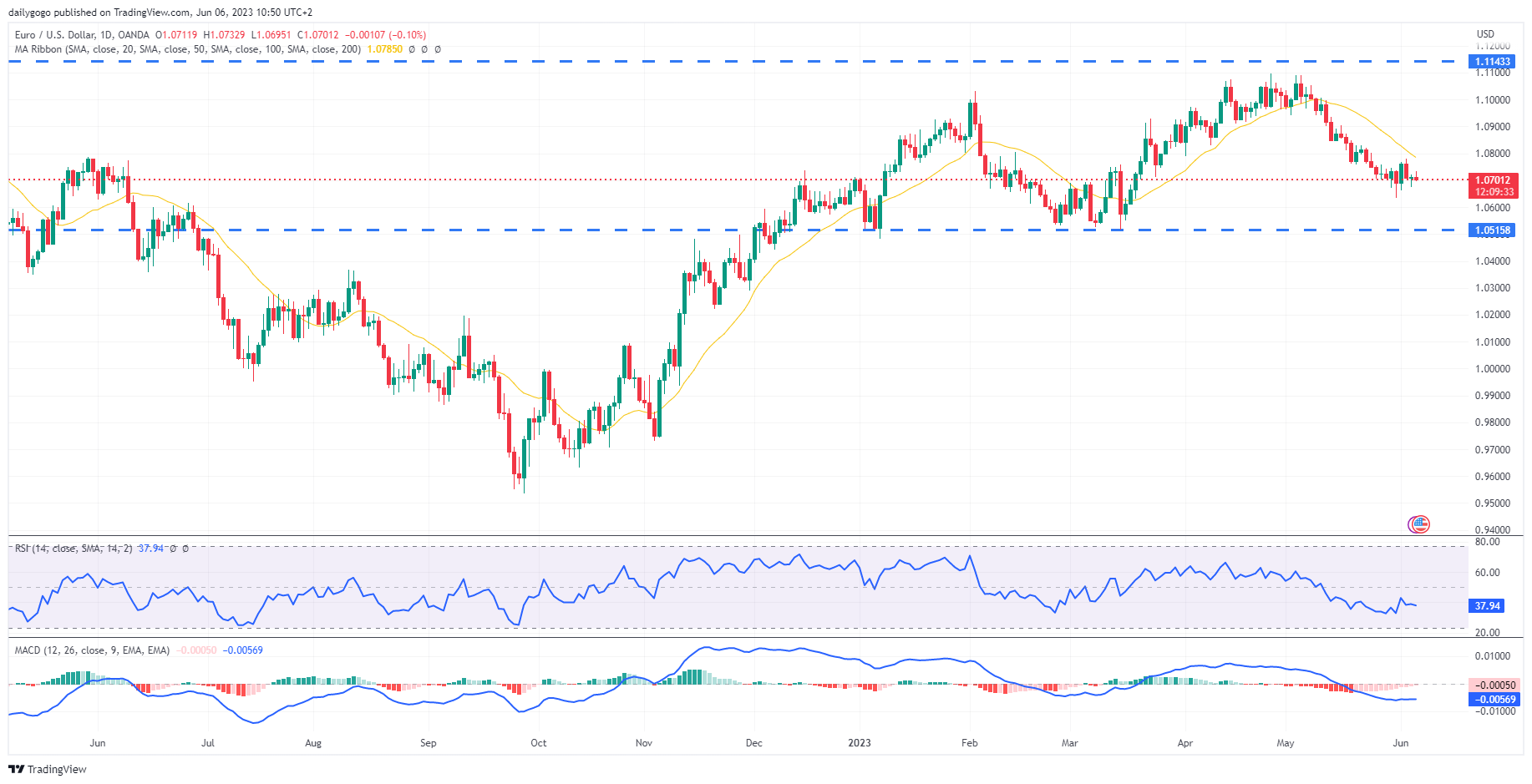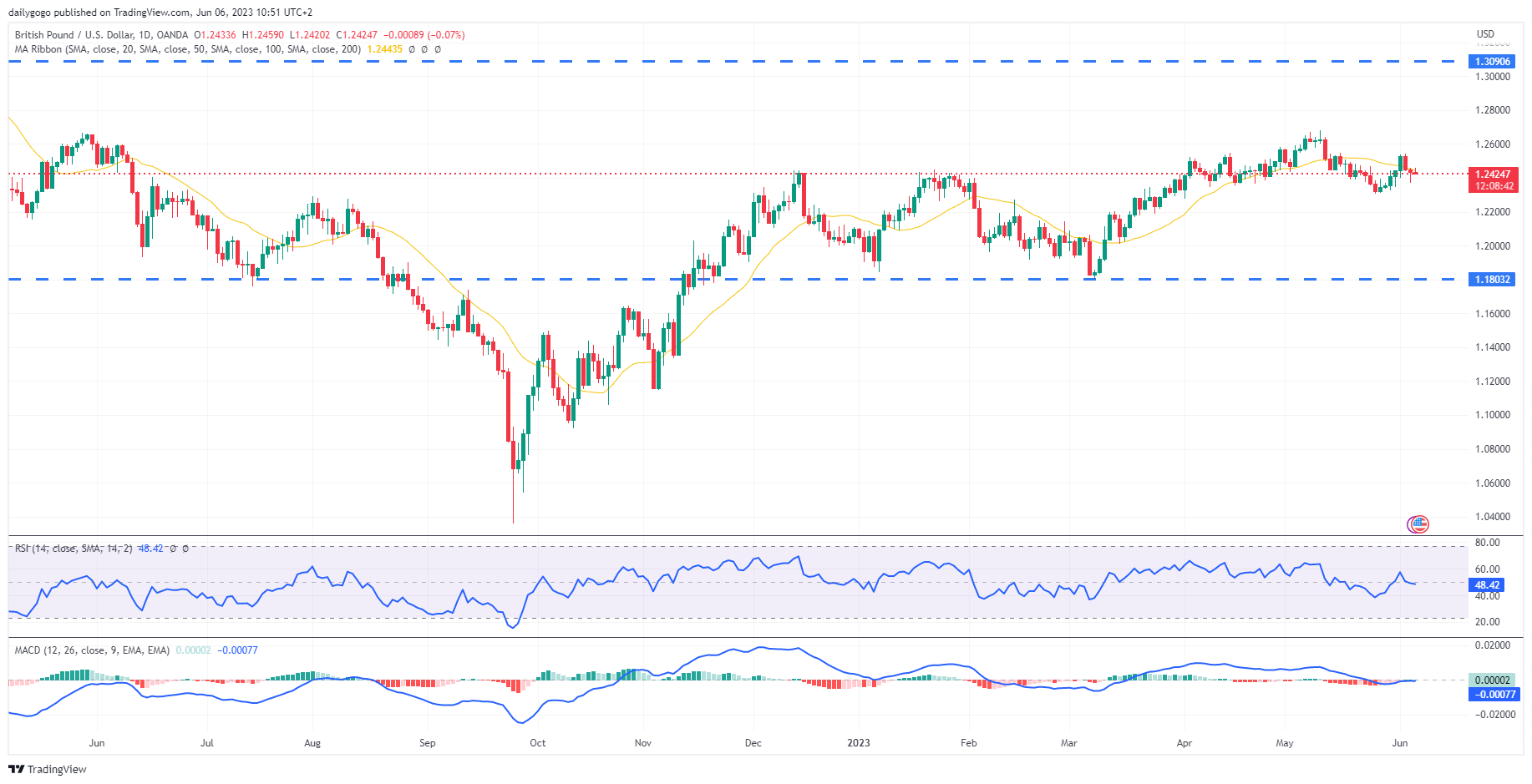EURUSD
- EUR/USD rose 0.1% to 1.0726, defying the unexpected decline in German factory orders by 0.4% in April.
- German factory orders falling indicates the challenges faced by Europe's largest economy following the pandemic-induced recession.
- The European Central Bank is highly likely to raise its interest rates next week, contrasting the approach of the Federal Reserve.
- ECB President Christine Lagarde stated it was too early to declare a peak in core inflation despite "signs of moderation."
- EUR/USD has been trading within a tight bear channel below the 50-day moving average since early May.
Closing statement: Despite the unexpected decline in German factory orders, EUR/USD managed to rise slightly. As the European Central Bank prepares for a potential interest rate hike, the currency pair's dynamics remain influenced by contrasting monetary policies between the ECB and the Federal Reserve. Market participants continue to monitor economic indicators and the bearish trend below the 50-day moving average for further insights into the future direction of EUR/USD.
GBPUSD
- GBP/USD slipped to 1.2422, forming a possible right shoulder in a small head and shoulders pattern on the daily graph.
- GBP/USD continues to find strong support in the low- to mid-1.2400s, maintaining its position above the rising 100-day moving averages.
- The Dollar Index, tracking the dollar against six major currencies, traded 0.1% lower at 103.793, retreating from its 2 1/2-month peak of 104.70 observed in late May.
- The unexpected softness in U.S. PMI services data exerted downward pressure on the dollar, reinforcing expectations for a pause in interest rate hikes after an extended period of tightening.
- Traders are closely monitoring GBP/USD as it navigates the potential head and shoulders pattern and seeks support at its current range.
| SMA (20) | Slightly Falling | ||
| RSI (14) | Slightly Falling | ||
| MACD (12, 26, 9) | Neutral |
Closing statement: GBP/USD experienced a slight decline, potentially forming the right shoulder of a small head and shoulders pattern. The currency pair maintains robust support and remains above its upward-trending 100-day moving averages. Meanwhile, the Dollar Index retreated from its recent peak due to weaker-than-expected U.S. PMI services data, which further solidified expectations for a pause in interest rate hikes. Traders are attentively observing GBP/USD for potential developments within this technical pattern and the broader market dynamics.
GOLD
- Gold prices remained steady on Tuesday after recording some gains in the previous session, as lackluster U.S. service sector data put pressure on the dollar and fueled speculation of a cooling economy.
- The U.S. dollar has experienced volatility in recent days as traders attempt to decipher the Federal Reserve's stance on interest rates ahead of its upcoming meeting.
- The latest jobs report released on Friday added uncertainty to the market, with the payrolls number suggesting room for another rate hike, while the rise in the unemployment rate and the slowdown in wage growth pointed in the opposite direction.
- Traders are divided on whether the Federal Reserve will proceed with a rate hike or maintain the current interest rates, as mixed signals have emerged in the past week.
- The uncertainty surrounding the Federal Reserve's decision on interest rates has contributed to a cautious market sentiment among gold traders.
| SMA (20) | Slightly Falling | |||
| RSI (14) | Neutral | |||
| MACD (12, 26, 9) | Neutral |
Closing statement: Gold prices remained unchanged, consolidating recent gains, as weak U.S. service sector data weighed on the dollar and raised doubts about the strength of the world's largest economy. Traders are closely monitoring the upcoming Federal Reserve meeting, where the decision on interest rates remains uncertain. The conflicting signals from the latest jobs report have added to the divergence of opinions among traders, leading to a cautious stance in the gold market.
CRUDE OIL
- Crude oil prices experienced a slight decline early on Tuesday, retracting from the gains achieved in the previous session due to concerns surrounding the global economic outlook, which overshadowed supply worries prompted by Saudi Arabia's significant output cut announcement.
- The crude oil market remains bearish, with some advanced economies, such as Germany, already showing signs of entering a recession.
- Market participants are eagerly awaiting the decision of the U.S. Federal Reserve regarding interest rates in June, as well as closely monitoring China's May trade data, which will provide insights into the demand from the world's second-largest oil consumer.
- China is currently grappling with a new wave of COVID-19 cases, which has temporarily affected traffic and economic activities, but it is anticipated to recover swiftly.
- The global economic backdrop and central bank decisions, coupled with China's trade data, will continue to be the key factors influencing crude oil prices in the near term.
| SMA (20) | Slightly Rising |
|
|
| RSI (14) | Slightly Falling | ||
| MACD (12, 26, 9) | Neutral |
Closing statement: Crude oil prices faced downward pressure as concerns over the global economic outlook outweighed supply-related factors, despite Saudi Arabia's substantial output cut announcement. The market remains cautious amid signs of recession in certain advanced economies, notably Germany. Investors are closely watching the upcoming decision by the U.S. Federal Reserve on interest rates, as well as China's May trade data, to gain insights into global oil demand. Although China is currently navigating a temporary setback due to a new wave of COVID-19 cases, expectations of a rebound in economic activity persist. The crude oil market will continue to be influenced by these factors as participants assess the broader market conditions.
DAX
- European stock markets experienced a downward drift on Tuesday, as concerns regarding slowing global growth and future central bank policy decisions weighed on investor sentiment.
- The DAX index in Germany saw a modest increase of 0.17%, while the CAC 40 in France remained flat and the FTSE 100 in the U.K. recorded a decline of 0.2%.
- In April, German factory orders unexpectedly dropped by 0.4%, signaling a challenging outlook for Europe's largest economy following its recession during the winter months of the pandemic.
- The final composite PMI index, released on Monday, indicated that the eurozone's business activity was supported by the dominant services industry, offsetting a deeper decline in the manufacturing sector. This index serves as a valuable indicator of overall economic health.
- Market participants remain watchful of the evolving global economic landscape and the potential impact of central bank decisions on market conditions.
| SMA (20) | Neutral |
| RSI (14) | Neutral |
| MACD (12, 26, 9) | Neutral |
Closing statement: European stock markets exhibited a downward drift as investors grappled with concerns about global growth slowdown and contemplated the forthcoming central bank policy decisions. Germany's factory orders unexpectedly declined in April, reflecting the challenges faced by Europe's largest economy following its recent recession. However, the final composite PMI index suggested that the eurozone's business activity was buoyed by the resilient services sector, offsetting weaknesses in manufacturing. Market participants will continue to closely monitor global economic dynamics and central bank actions, which will likely influence the trajectory of European stock markets in the near term.




